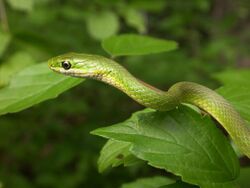Biology:Opheodrys
| Opheodrys | |
|---|---|

| |
| Opheodrys aestivus | |
| Scientific classification | |
| Domain: | Eukaryota |
| Kingdom: | Animalia |
| Phylum: | Chordata |
| Class: | Reptilia |
| Order: | Squamata |
| Suborder: | Serpentes |
| Family: | Colubridae |
| Subfamily: | Colubrinae |
| Genus: | Opheodrys Fitzinger, 1843 |
| Synonyms | |
|
Chlorosoma, Phyllophilophis,[1] Liochlorophis | |
Opheodrys is a genus of small to medium-sized nonvenomous colubrid snakes commonly referred to as green snakes. In North America the genus consists of two distinct species. As their common names imply, the rough green snake has keeled dorsal scales, whereas the smooth green snake has smooth dorsal scales.
Species
Valid species
The following two species are recognized as being valid.[2]
- Opheodrys aestivus (Linnaeus, 1766) – rough green snake
- Opheodrys vernalis (Harlan, 1827) – smooth green snake
Nota bene: A binomial authority in parentheses indicates that the species was originally described in a genus other than Opheodrys.
Species removed from the genus
The genus Opheodrys at one time included two Asian species: O. herminae, which is endemic to Japan , and O. major, which is endemic to Central/South China , Taiwan, N. Vietnam, and Laos. These were removed from the genus by Cundall in 1981[3]
- Opheodrys herminae (Boettger, 1895) = Ptyas herminae (Boettger, 1895) – Sakashima green snake[4]
- Opheodrys major (Günther, 1858) = Ptyas major (Günther, 1858) – greater green snake[5]
Subspecies no longer recognized
The following subspecies of Opheodrys are no longer recognized by ITIS:[2]
- Opheodrys aestivus aestivus (Linnaeus, 1766) – northern rough green snake
- Opheodrys aestivus carinatus Grobman, 1984 – Florida rough green snake
- Opheodrys vernalis blanchardi Grobman, 1941 – western smooth green snake
- Opheodrys vernalis borealis Grobman, 1992 – northern smooth green snake
- Opheodrys vernalis vernalis (Harlan, 1827) – eastern smooth green snake.
However, as of May 2023, The Reptile Database still recognizes the subspecies O. aestivus carinatus in addition to the nominotypical subspecies O. a. aestivus.[6]
Geographic range
Green snakes of the genus Opheodrys are found in the United States , southern Canada , and northern Mexico.[7]
Description
Green snakes are so named because they are typically solid green in color dorsally, with a cream-colored or yellow underside. They are thin-bodied snakes that rarely exceed 90 cm (around 36 inches) in length.[8] They have large eyes and blunt shaped heads.
Habitat
Green snakes are often found in dense, low lying vegetation near a permanent water source.[9]
Behavior
Green snakes have been known to follow human activity. They rely on their color for camouflage and will usually attempt to escape if threatened.
Diet
Their primary diet is soft-bodied arthropods, including crickets, spiders, moths, butterflies, and grasshoppers.[9]
Reproduction
Green snakes of the genus Opheodrys are oviparous.[10]
References
- ↑ Wright AH, Wright AA (1957). Handbook of Snakes of the United States and Canada. Ithaca and London: Comstock. 1,105 pp. (in 2 volumes). (Genus Opheodrys, pp. 551-564, Figures 164-166, Map 43).
- ↑ 2.0 2.1 "Opheodrys. ITIS (Integrated Taxonomic Information System)". https://www.itis.gov/servlet/SingleRpt/SingleRpt?search_topic=TSN&search_value=174171.
- ↑ "CNAH". http://www.cnah.org/detail.asp?id=211.
- ↑ Species Ptyas herminae at The Reptile Database www.reptile-database.org.
- ↑ Species Ptyas major at The Reptile Database www.reptile-database.org.
- ↑ Species Opheodrys aestivus at The Reptile Database www.reptile-database.org.
- ↑ Smith HM, Brodie ED Jr (1982). Reptiles of North America: A Guide to Field Identification. New York: Golden Press. 240 pp. ISBN:0-307-13666-3. (Opheodrys, pp. 188-189).
- ↑ Conant R (1975). A Field Guide to Reptiles and Amphibians of Eastern and Central North America, Second Edition. Boston: Houghton Mifflin. xviii + 429 pp. + Plates 1-42. ISBN:0-395-19979-4 (hardcover), ISBN:0-395-19977-8 (paperback). (Opheodrys, pp. 184-186 + Plate 25 + Maps 134-135).
- ↑ 9.0 9.1 Behler JL, King FW (1979). The Audubon Society Field Guide to North American Reptiles and Amphibians. New York: Alfred A. Knopf. 743 pp. ISBN:0-394-50824-6. (Opheodrys, pp. 639-641+ Plates 475-477).
- ↑ Schmidt KP, Davis DD (1941). Field Book of Snakes of the United States and Canada. New York: G.P. Putnam's Sons. 365 pp. (Opheodrys, pp. 118-121, Figures 27-28 + Plate 12 on p. 332).
Further reading
- Fitzinger L (1843). Systema Reptilium, Fasciculus Primus, Amblyglossae. Vienna: Braumüller & Seidel. 106 pp. + indices. (Opheodrys, new genus, p. 26). (in Latin).
External links
| Wikimedia Commons has media related to Opheodrys aestivus. |
- Genus Opheodrys at The Reptile Database
- Smooth Green Snake - Opheodrys vernalis Species account from the Iowa Reptile and Amphibian Field Guide
- Georgia Department of Natural Resources -- Laws Related to Native Wildlife[yes|permanent dead link|dead link}}]
Wikidata ☰ Q783773 entry
 |

